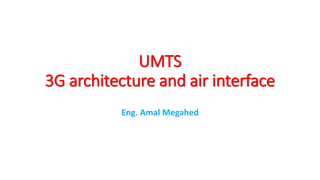
3G architecture.pptx
- 1. UMTS 3G architecture and air interface Eng. Amal Megahed
- 26. Considered as a reference signal for error rate Contains power control and BS code informatio Contains frame start and slot start information Contains network name, country code, routing area code and cell identity information (broadcast channel) Search for mobile location in which cell (paging) random access for mobile on the cell
- 29. • Logical Channels Logical channels are used to separate different kinds of data flows that have to be transferred over the air interface. The channels contain no information on how the data is later transmitted over the air.
- 30. • The BCCH (Broadcast Control Channel): This channel is monitored by all mobile devices in Idle state to receive general system information from the network. The parameters are further grouped into System Information Block (SIB) messages to help the mobile device to decode the information and to save air interface bandwidth. • The PCCH (Paging Control Channel): This channel is used to inform users of incoming calls or SMS messages. Paging messages are also used for packet-switched calls if new data arrives from the network once all physical resources (channels) for a subscriber have been released owing to a long period of
- 31. • The CCCH (Common Control Channel): This channel is used for all messages from and to individual mobile devices (bidirectional) that want to establish a new connection with the network. – The DCCH (Dedicated Control Channel): a DCCH only transports data for a single subscriber. For example, to transport messages for the MM and CC protocols for circuit- switched services, Packet Mobility Management (PMM) and SM messages for packet- switched services from and to the MSC and SGSN. – The DTCH (Dedicated Traffic Channel): This channel is used for user data transfer between the network and a single user. – The CTCH (Common Traffic Channel): This channel is used for cell broadcast information.
- 34. • Transport Channels Transport channels prepare downlink data frames for transmission over the air interface by splitting them up into smaller parts, which are encapsulated into RLC/MAC-frames that are more suitable for transmission over the air interface. The RLC/MAC header that is placed in front of each frame contains, among other things, the following information: • length of the frame (10, 20, 40 or 80 milliseconds); • type of integrity checking mechanism (CRC checksum); • channel coding format for error detection and correction; • rate matching in case the speed of the physical channel and the layers above do not match; • control information for detection of discontinuous transmission (DTX) in case the other end has no data to send at a particular time.
- 35. • The BCH (Broadcast Channel): Transport channel variant of the logical BCCH. • The DCH (Dedicated Channel): This transport channel combines data from the logical DTCH and the logical DCCH. The channel exists in both uplink and downlink directions as data is exchanged in both directions. • The PCH (Paging Channel): Transport channel variant of the logical PCCH. • The FACH (Forward Access Channel): This channel is used by the network to send RRC Connection Setup messages to mobile devices, which have indicated via the RACH that they wish to establish a connection with the network. The message contains information for the mobile device on how to access the network. If the network has assigned a dedicated channel, the message contains, for example, information on which spreading codes will be used in uplink and downlink directions.
- 36. • The RACH (Random Access Channel): The bidirectional logical CCCH is called RACH on the transport layer in uplink direction. This channel is used by mobile devices to send RRC Connection Request messages to the network if they wish to establish a dedicated connection with the network (e.g. to establish a voice call). Furthermore, the channel is used by mobile devices to send user packet data (in Cell-FACH state) if no dedicated channel exists between the mobile device and the network. It should be noted, however, that this
- 38. • Physical Channels: are responsible for offering a physical transmission medium for one or more transport channels. Furthermore, physical channels are responsible for channel coding.
- 41. • The P-CCPCH (Primary Common Control Physical Channel): This channel is used for distributing broadcast information in a cell. • The S-CCPCH (Secondary Common Control Physical Channel): This channel is used to broadcast the PCH and the FACH. • The PRACH (Physical Random Access Channel): The physical implementation of the RACH. • The AICH (Acquisition Indication Channel): This channel is not shown in the channel overview figures as there is no mapping of this channel to a transport channel. The channel is used exclusively together with the PRACH during the connection establishment of a mobile device with the network.
- 42. • The DPDCH (Dedicated Physical Data Channel): This channel is the physical counterpart of a dedicated channel to a single mobile device. The channel combines user data and signaling messages from (Packet) MM, CC and SM. • The DPCCH (Dedicated Physical Control Channel): This channel is used in addition to a DPDCH in both uplink and downlink directions. It contains layer 1 information like Transmit Power Control (TPC) bits for adjusting the transmission power. Furthermore, the channel is also used to transmit the so- called pilot bits. These bits always have the same value and can thus be used by the receiver to generate a channel estimation, which is used to decode the remaining bits of the DPCCH and the DPDCH.
Editor's Notes
- RNC: Radio Network Center
- UTRAN: UMTS Terrestrial Radio Access Network
- MSC: Mobile switching center
- MM: mobility management, CC: call control